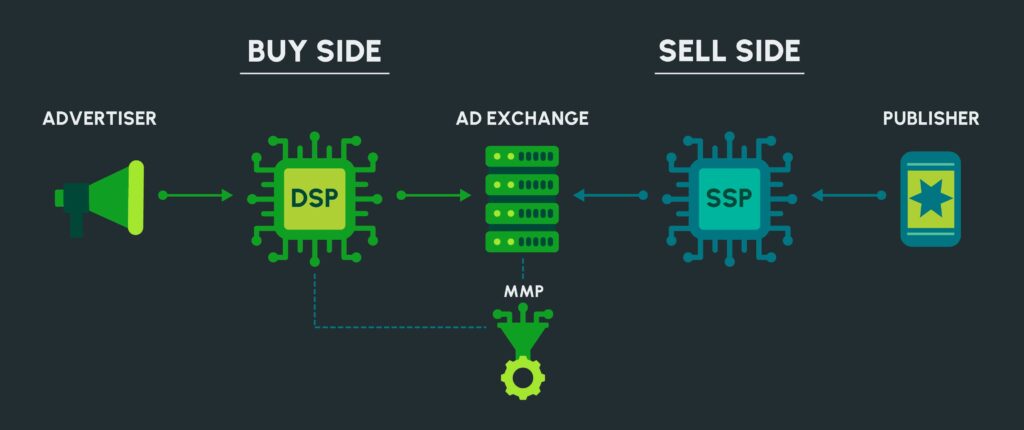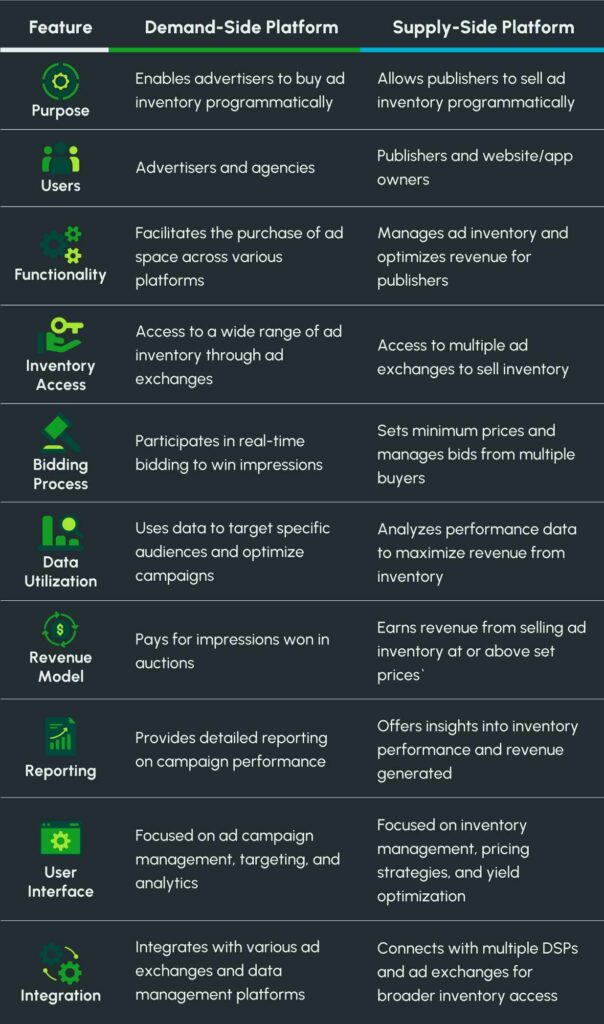
Choosing the right tools for programmatic advertising can feel like navigating a maze. With so many platforms needing to be evaluated—DSP vs. SSP vs. Ad Exchanges—it’s easy for marketers to feel overwhelmed by the complexity of it all.
We understand how crucial it is for brands and app marketers to optimize every step of their advertising strategy, and that starts with knowing how these platforms work together. This guide will help you make smarter, more informed decisions by examining the key differences between demand-side platforms (DSPs), supply-side platforms (SSPs), and ad exchanges.
Our insights stem from years of industry leadership, powered by advanced AI and data-driven creative strategies that have propelled the success of global brands. Ready to demystify the adtech ecosystem? Let’s break it down.
What is a DSP (Demand-Side Platform)?
A Demand-Side Platform, or DSP, is your gateway to reaching the right audience at scale. Think of it as a sophisticated tool that allows advertisers to buy mobile ad inventory across multiple networks and exchanges, all in one place.
Rather than negotiating with individual publishers or guessing which media will perform best, a DSP automates the entire process—analyzing data and bidding on impressions in real-time.
Why does this matter for mobile ads? Because the fast-moving mobile ecosystem demands pace and precision.
A DSP gives you access to rich data that helps you target users based on their behaviors, interests, and app usage patterns. Whether you’re launching a user acquisition campaign for a new game or retargeting high-value users to re-engage with your app, the DSP ensures you’re delivering ads exactly when and where they’ll have the most impact.
For mobile advertisers, Aarki’s mobile DSP takes this a step further. Our AI-powered platform doesn’t just execute campaigns—it learns from them, refining audience targeting and creative delivery based on performance data. The result? More intelligent, more impactful mobile ads that reach users when they’re most ready to engage.
In short, a DSP is your command center for mobile advertising, giving you the power to buy programmatic ads efficiently while maximizing return on investment (ROI).
What is an SSP (Supply-Side Platform)?
On the flip side of programmatic advertising, we have the Supply-Side Platform, or SSP. While a DSP helps advertisers buy mobile ad space, an SSP is designed for publishers. It’s the tool that app developers, media owners, and mobile publishers use to sell their ad inventory to the highest bidder.
An SSP connects to multiple ad exchanges and DSPs, giving publishers the ability to reach a wider range of buyers—automatically and in real time. Instead of negotiating with individual advertisers, an SSP lets the technology handle the heavy lifting. It runs an auction for each available ad impression and sells it to the advertiser willing to pay the highest price. This process is often referred to as “real-time bidding (RTB).”
For mobile publishers, an SSP is crucial because it maximizes the value of their inventory. It’s not just about filling ad slots; it’s about ensuring those slots are filled with the highest-paying, most relevant ads. This results in a better experience for users, as they’re more likely to see ads that align with their interests and behaviors. Plus, with access to more buyers, publishers have the chance to increase their revenue potential.
SSPs also allow for more control. Publishers can set parameters around who can buy their inventory, ensuring brand safety and controlling the types of ads that appear on their apps. In the mobile space, where user experience and engagement are key, having this level of control is invaluable for maintaining the quality of the ad experience.
In short, an SSP ensures that publishers are getting the most value out of every impression for their inventory, all while keeping the process seamless and efficient.
DSP vs. SSP: Key Differences and How They Complement Each Other
Understanding the distinction between Demand-Side Platforms (DSPs) and Supply-Side Platforms (SSPs) is essential for marketers looking to navigate the complexities of programmatic advertising. While both play pivotal roles in the digital advertising ecosystem, their functions and audiences are quite different.
1. The Core Functionality: Demand vs. Supply
At its core, a DSP is designed for advertisers. It enables them to purchase ad inventory across various networks efficiently. The DSP automates the buying process, leveraging data to target the right users at the right time. It empowers marketers to reach potential customers based on behaviors, preferences, and demographics, making it an invaluable tool for driving user acquisition and engagement.
In contrast, an SSP serves the needs of publishers. Its primary function is to help them manage and sell their ad inventory. SSPs optimize how publishers offer their ad space to potential buyers, including multiple DSPs and ad exchanges. By maximizing demand for their inventory, SSPs ensure that publishers can achieve the best possible pricing for their ads.
2. Who Uses Them?
The audience for these platforms further underscores their differences. Advertisers and agencies leverage DSPs to streamline their ad purchases and enhance campaign effectiveness. With Aarki’s DSP, for instance, marketers can tap into advanced AI capabilities that optimize campaigns in real-time, allowing for better targeting and higher ROI.
On the flip side, publishers, app developers, and website owners use SSPs to maintain control over their inventory and generate revenue from their available ad space. By utilizing an SSP, they can access a broader range of demand sources, ensuring they don’t miss out on potential ad revenue.
3. How They Work Together
While DSPs and SSPs have distinct roles, they complement each other in the programmatic ecosystem. When an advertiser wants to run a campaign, the DSP places bids for ad impressions available through the SSP. This interconnectedness creates a seamless flow of inventory from publishers to advertisers, allowing both parties to achieve their goals.

The Role of Ad Exchanges in the DSP and SSP Ecosystem
While Demand-Side Platforms (DSPs) and Supply-Side Platforms (SSPs) are integral components of the programmatic advertising landscape, ad exchanges also play a crucial role in facilitating the buying and selling of ad inventory. Understanding how ad exchanges fit into this ecosystem can further illuminate the interplay between DSPs and SSPs.
1. What Are Ad Exchanges?
Ad exchanges act as digital marketplaces where advertisers (using DSPs) and publishers (using SSPs) can buy and sell advertising space in real-time. They enable automated auctions for ad inventory, allowing multiple buyers and sellers to interact without direct negotiation. This efficiency streamlines the ad-buying process, ensuring transactions occur swiftly and transparently
2. How Do Ad Exchanges Work?
When an ad impression becomes available, an ad exchange triggers an auction among interested DSPs. Here’s how it typically works:
- Ad Request: A user visits a website or app with available ad space, prompting an ad request to the ad exchange.
- Auction: The ad exchange sends the ad request to connected DSPs, which then bid based on the value they place on reaching that specific user.
- Winning Bid: The highest bidder wins the impression, and the ad is displayed to the user.
This real-time bidding process ensures that advertisers can compete effectively for impressions and publishers can optimize their inventory to maximize revenue.
3. The Interplay Between DSPs, SSPs, and Ad Exchanges
The relationship between DSPs, SSPs, and ad exchanges is symbiotic. DSPs depend on ad exchanges to access a wide range of inventory across various SSPs, enabling advertisers to reach diverse audiences. Conversely, SSPs rely on ad exchanges to connect them with numerous DSPs, ensuring their ad inventory is exposed to the highest possible demand.
This interconnected network allows for greater efficiency and optimization in the advertising process. Advertisers can target specific audiences using the data provided by DSPs, while publishers can better manage their inventory through SSPs. The real-time nature of ad exchanges facilitates this.
Aarki has unparalleled visibility into global ad exchanges, allowing advertisers to gain insights from vast data. This comprehensive access enables Aarki to optimize campaigns in real-time, ensuring that advertisers can engage with their target audiences across multiple channels effectively.
Another Player in the Ecosystem: Mobile Measurement Partners (MMP) for Reliable Attribution
Mobile Measurement Partners (MMPs) play a crucial role by providing insights into user behavior and campaign effectiveness. These mobile attribution platforms help advertisers track and analyze the performance of their marketing efforts across various channels, including DSPs and ad exchanges. By connecting the dots between user interactions and ad spend, MMPs enable advertisers to optimize their strategies and maximize return on investment.
MMPs serve several vital purposes within the advertising landscape:
- Attribution: They attribute user actions (such as app installs or in-app purchases) to specific marketing campaigns, helping advertisers understand which strategies drive conversions.
- Analytics: MMPs offer comprehensive analytics, providing insights into user engagement, retention, and lifetime value.
- Campaign Optimization: By analyzing performance data, MMPs allow advertisers to make informed decisions on budget allocation and targeting.
Among several prominent MMPs, the ones leading the industry include AppsFlyer, Singular, and Adjust.
By integrating MMPs into advertising strategies, you can ensure data-driven decisions to enhance campaign effectiveness. Navigating this complex eco-system becomes easier.
Unleash Your App’s Potential
Understanding the distinctions between DSPs, SSPs, and ad exchanges is paramount for growth marketers aiming to maximize their reach and efficacy. Each component plays a vital role in facilitating seamless transactions, enhancing targeting capabilities, and optimizing ad spend. By choosing the right mix of these tools, advertisers can navigate the complexities of the market, ensuring that their campaigns resonate with the intended audience.As you explore your options, consider how Aarki, with its advanced technology and creative strategies, can elevate your mobile advertising initiatives. For tailored AI-powered solutions that focus on privacy, creative excellence, and driving results, feel free to contact us.